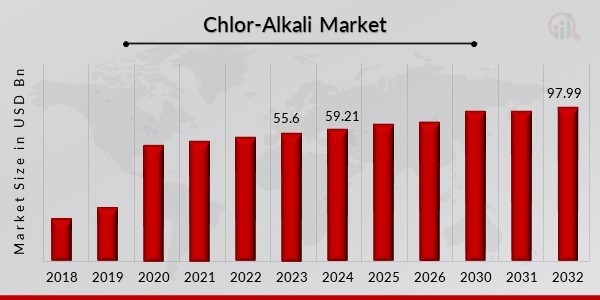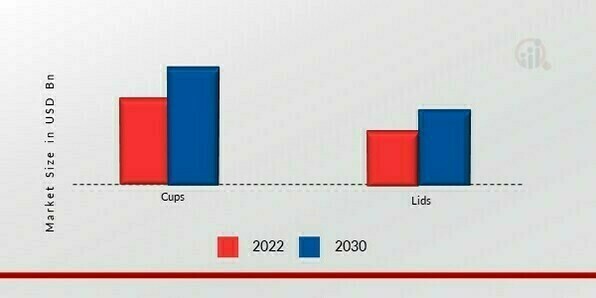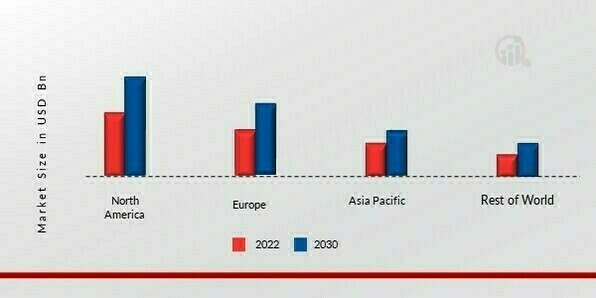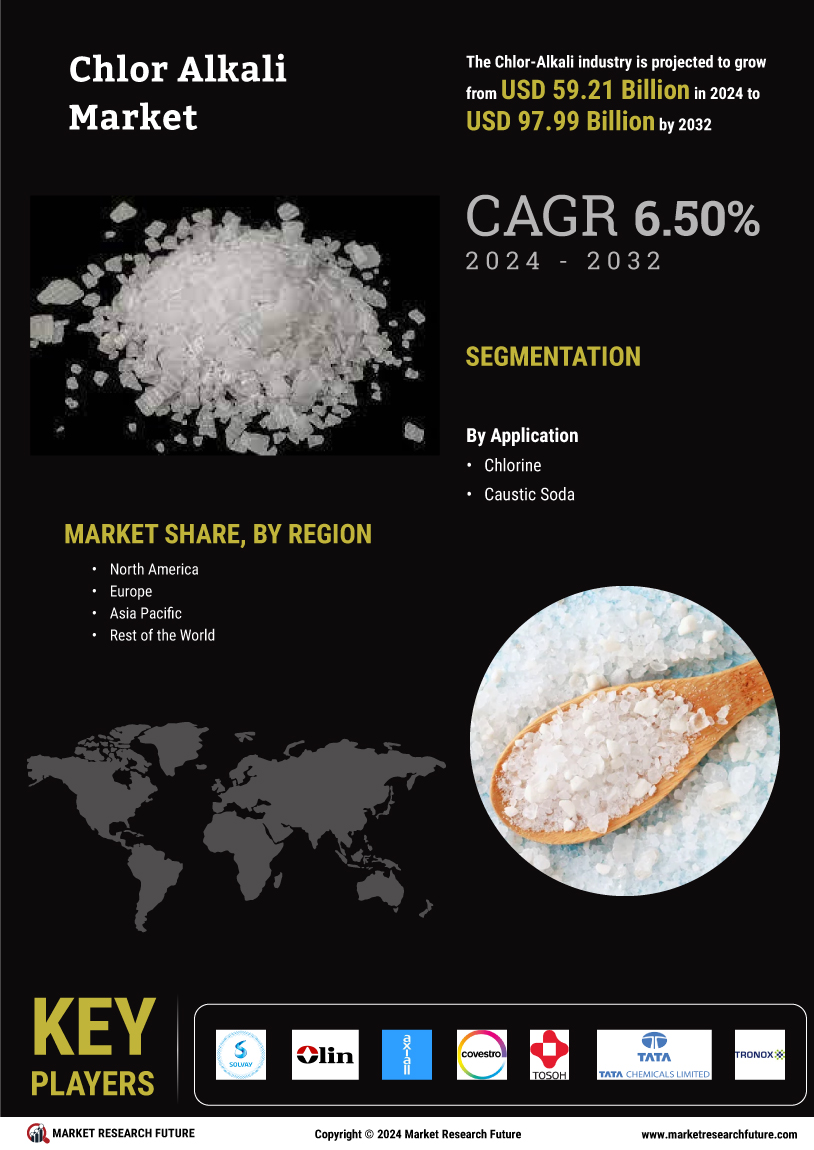Global Chlor Alkali Market Overview
The Chlor Alkali Market Size was valued at USD 55.6 Billion in 2023. The Chlor-Alkali industry is projected to grow from USD 59.21 Billion in 2024 to USD 97.99 Billion by 2032, exhibiting a compound annual growth rate (CAGR) of 6.50% during the forecast period (2024 - 2032). Chlor alkali manufacturing plants produce two widely used commodity chemicals such as chlorine and caustic soda (NaOH). The process consumes a significant amount of electricity which accounts for over 40% of total operating costs. Membrane cell technology is prominently used in the production of chlor alkali, and this technology accounts for a fourth-fifth of the total installed production capacity of chlor alkali around the world. Other technologies such as the diaphragm and mercury cell account for the rest of the share in production technologies.

Source: Secondary Research, Primary Research, MRFR Database, and Analyst Review
Chlor-Alkali Market Trends
-
Rising Adoption of Greener Production Technologies by Major Manufacturers to Bolster Market Growth.
Chlor alkali production technology is subjugated by using membrane cell technology. However, many production facilities still operate using the mercury cell process. Mercury is a highly toxic element, and environmental concerns have compelled lawmakers to implement stringent environmental regulations on such processes. As a result, manufacturers are converting their mercury cell technologies to greener technologies such as membrane cells. In 2017 and 2018, many plants in Europe converted their technologies, and the same is likely to get reciprocated in different parts of the world in the coming years on the back of rising environmental concerns. Also, in September 2020, Euro Chlor, the European association of chlor alkali manufacturers, launched its strategy for this industry's sustainable future in Europe, highlighting the role of green technology in achieving its goals. The European chlor alkali industry successfully phased out mercury-cell technology at Europe’s chlorine plants in 2018.
Source: Secondary Research, Primary Research, MRFR Database, and Analyst Review
Additionally, Chlorine is used in large quantities in vinyl production. Various downstream chemicals are produced using chlorine which is further used to manufacture polyvinyl chloride (PVC). PVC is the world’s third-largest used polymer. It is prominently used in the construction industry to make pipes, window frames, and other products. The thriving construction industry in emerging countries has boosted the demand for chlorine in vinyl production. Moreover, PVC applications in various end-use industries are steadily increasing, which is expected to generate lucrative growth opportunities in the forthcoming years. For example, PVC tapes and cases are healthily used in electrical applications due to their unique properties. The emergence of electric vehicles in the developing world is likely to boost the consumption of PVC and chlorine used in vinyl. Thus, healthy demand from end-use industries is expected to drive the market.
Chlor-Alkali Market Segment Insights
Chlor-Alkali Application Insights
The Chlor-Alkali Market segmentation, based on Application, includes (Chlorine {Water Treatment, Paper & Pulp, Inorganics, Intermediates, Organics, Vinyl, and Others} and Caustic Soda {Textile, Alumina, Soap & Detergents, Organics, Inorganics, Pulp & Paper, Water Treatment, and others}). The vinyl segment dominates the global market in terms of chlorine consumption. Chlorine derivatives are prominently used in PVC production. The chlorine demand often fluctuates in tandem with the production of PVC. Besides, chlorine produces several organic, inorganic, and intermediate chemicals that collectively account for over one-third of global consumption. Water treatment and paper & pulp account for a single-digit share of chlorine consumption.
Figure 2: Chlor-Alkali Market, by Application, 2023 & 2032 (USD Billion)

Source: Secondary Research, Primary Research, MRFR Database, and Analyst Review
Chlor-Alkali Regional Insights
By region, the study provides market insights into North America, Europe, Asia-Pacific, and the Rest of the World. Asia Pacific accounted for the largest share of the global market in 2020. China dominates the Asia-Pacific region with over 70% share in regional consumption. Strong growth in the construction industry has boosted the demand for chlorine used in vinyl production. Besides, substantial growth in demand for PVC pipes in the agricultural sector has further aided the market's growth. The demand for caustic soda has been strongly driven by the adoption of aluminum in the automotive and industrial sectors. Moreover, the paper & pulp industry has also contributed to significant growth. The bolstering paper packaging industry in the region is expected to increase the demand for caustic soda over the forecast period.
Figure 3: CHLOR-ALKALI MARKET SHARE BY REGION 2023 (%)

Source: Secondary Research, Primary Research, MRFR Database, and Analyst Review
North America held the second-largest market share, closely followed by Europe. North America is one of the largest exporters of chlor alkali products in the world. The resurgent construction industry is likely to boost the production of PVC and demand for chlorine over the foreseeable period. The supply in Europe is tight, and the region is a forerunner in achieving green goals in the industry. The demand is expected to increase steadily over the forecast period due to slow developments in the end-use industries. Western European countries such as Germany, France, the U.K., Spain, and Italy dominate the regional market.
Chlor-Alkali Key Market Players & Competitive Insights
Major market players are spending a lot of money on R&D to increase their product lines, which will help the Chlor-Alkali market grow even more. Market participants are also taking a range of strategic initiatives to grow their worldwide footprint, with key market developments such as new product launches, contractual agreements, mergers and acquisitions, increased investments, and collaboration with other organizations. Competitors in the Chlor-Alkali industry must offer cost-effective items to expand and survive in an increasingly competitive and rising market environment.
The major market players are investing a lot of money in R&D to expand their product lines, which will spur further market growth for Chlor-Alkali. With significant market development like new product releases, contractual agreements, mergers and acquisitions, increased investments, and collaboration with other organizations, market participants are also undertaking various strategic activities to expand their global presence. To grow and thrive in a market climate that is becoming more competitive and growing, competitors in the Chlor-Alkali industry must offer affordable products.
Manufacturing locally to cut operating costs is one of the main business tactics manufacturers use in the global Chlor-Alkali industry to benefit customers and expand the market sector. The Low-Profile Additives market has recently given medicine some of the most important advantages. Major Chlor-Alkali market players, including Zochem (US), SILOX SA (Belgium), American Chemet Corporation (US), H. Chemicals (Canada), and others, are attempting to increase market demand by funding R&D initiatives.
Olin Corporation is a manufacturer and distributor of chemical products and ammunition. It produces chlorine and caustic soda, vinyl, epoxies, chlorinated organics, bleach, and hydrochloric acid. The company also offers sporting, law enforcement, and small-caliber military ammunition, as well as reloading components and industrial cartridges.
Also, Axiall, created by the merger of Georgia Gulf and the commodity chemicals business of PPG, represents a new kind of chemistry company; one that works to responsibly harness applied chemistry to solve common problems, improve everyday life and drive human progress. Blending a strong, downstream building products business with core materials capabilities, Axiall delivers life-enhancing benefits.
Key Companies in the Chlor-Alkali market include
- Solvay SA (Belgian)
-
Olin Corporation (US)
- Axiall Corporation (US)
- Akzo Nobel NV (The
- The Netherlands) Bayer AG (Germany)
- Covestro AG (Germany)
-
Tosoh Corporation (Japan)
- Tata Chemicals Ltd (India)
- Tronox Limited (US)
- Xinjiang Zhongtai Chemical Co. Ltd (China)
Chlor-Alkali Industry Developments
In December 2021, Reliance Industries Ltd announced USD 2 billion to produce chemicals with RSC Ltd.
In January 2021, Koyuncu group, Turkey's largest salt provider, made agreements with Inovyn, a London-based premier chemical company, to supply chloralkali technology in a deal worth 16 million Euros.
Chlor-Alkali Market Segmentation
Chlor-Alkali Application Outlook
Chlor-Alkali Regional Outlook
- North America
- Europe
- Germany
- France
- UK
- Italy
- Spain
- Rest of Europe
- Asia-Pacific
- China
- Japan
- India
- Australia
- South Korea
- Australia
- Rest of Asia-Pacific
- Rest of the World
- Middle East
- Africa
- Latin America
| Attribute/Metric |
Details |
| Market Size 2023 |
USD 55.6 Billion |
| Market Size 2024 |
USD 59.21 Billion |
| Market Size 2032 |
USD 97.99 Billion |
| Compound Annual Growth Rate (CAGR) |
6.50% (2024-2032) |
| Base Year |
2023 |
| Market Forecast Period |
2024-2032 |
| Historical Data |
2018 & 2020 |
| Market Forecast Units |
Value (USD Billion) |
| Report Coverage |
Revenue Forecast, Market Competitive Landscape, Growth Factors, and Trends |
| Segments Covered |
Application, and Region |
| Geographies Covered |
North America, Europe, Asia Pacific, and the Rest of the World |
| Countries Covered |
The U.S, Canada, Germany, France, the UK, Italy, Spain, China, Japan, India, Australia, South Korea, and Brazil |
| Key Companies Profiled |
Solvay SA (Belgian), Olin Corporation (US), Axiall Corporation (US), Akzo Nobel NV (The Netherlands), Bayer AG (Germany), Covestro AG (Germany), Tosoh Corporation (Japan), Tata Chemicals Ltd (India), Tronox Limited (US), and Xinjiang Zhongtai Chemical Co. Ltd (China) |
| Key Market Opportunities |
· Increasing demand for chlorine and its derivatives particularly from the petrochemical industry. |
| Key Market Dynamics |
· Rapid urbanization · Increasing disposable income · Population growth. |
Chlor Alkali Market Highlights:
Frequently Asked Questions (FAQ) :
The Chlor-Alkali Market size was valued at USD 55.6 Billion in 2023.
The global market is projected to grow at a CAGR of 6.50% during the forecast period, 2024-2032.
Asia Pacific had the largest share of the Chlor-Alkali Market.
The key players in the market are Solvay SA (Belgian), Olin Corporation (US), Axiall Corporation (US), Akzo Nobel NV (The Netherlands), Bayer AG (Germany), Covestro AG (Germany), Tosoh Corporation (Japan), Tata Chemicals Ltd (India), Tronox Limited (US), and Xinjiang Zhongtai Chemical Co. Ltd (China)
The vinyl categories dominated the market in 2023.


















